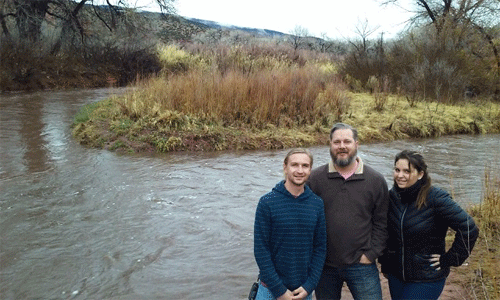Recent News
Ferenchak named chair of Transportation Research Board Pedestrian Committee
October 31, 2025
Ferenchak named APBP 2025 Research Professional of the Year
October 1, 2025
UNM professor to speak at TEDxABQ event
September 24, 2025
NSF funds research to investigate whether treated wastewater can help mitigate water scarcity in arid regions without compromising river ecosystem health
September 2, 2025
News Archives
Dr. Gonzalez-Pinzon's Graduate Students Vanessa Garayburu and Cameron Herrington Receive NM WRRI Student Water Research Grants
September 21, 2015
Dr. Gonzalez-Pinzon’s hydro-systems research laboratory is focused on understanding in-stream nutrient processing and metabolism along whole river continuums. While developing their research endeavors, graduate students Vanessa Garayburu and Cameron Herrington received seed grants from the New Mexico Water Resources Research Institute. These grants will help them complete their research work and collect preliminary data to pursue larger research grants in the near future.

From left to right: Dr. Gonzalez-Pinzon's graduate students Jacob Mortensen, Cameron Herrington, and Vanessa Garayburu.
M.S. student Vanessa Garayburu will investigate how nutrient processing changes along a river continuum by conducting slow filtration column experiments. Vanessa will incubate columns with native and pre-sieved sediments in representative sites of eight stream orders (from small to big rivers) along the Jemez River – Rio Grande continuum. With these experiments Vanessa will be able to determine, for the first time, how natural changes in bacterial communities and sediment composition occurring seasonally along a river continuum define nutrient processing, as well as the relationship between biofilm formation and riverbed sediment diversity. This work will support the development of a new generation of field and lab experiments to quantify nutrient processing in large rivers where only about 5% of all reported tracer experiments have been conducted.
Ph.D. student Cameron Herrington will develop a hydrologic toolbox to predict solute transport and to inform sampling frequencies at small and large stream orders using empirical relationships developed from multiple tracer injections spanning several orders of magnitude in discharge and reach length, and data-based mechanistic transport models. Cameron’s work will also serve to provide an important resource for the prediction of the arrival time and dispersion of a contaminant plume in an emergency situation that threatens the public water supply, as recently occurred with the Animas River spill. The objective Cameron’s research is to create a user-friendly computational toolbox capable of: 1) estimating injection mass needed to properly characterize a tracer breakthrough curve (BTC) as a function of river discharge and longitudinal sampling distance, 2) predicting arrival time, time-to-peak concentration and mean travel time of a solute BTC as a function of longitudinal distance and discharge, 3) analyzing nutrient uptake kinetics along river reaches from short-term and plateau tracer injections, and 4) characterizing expected concentrations of contaminants in rivers as a function of observed upstream BTCs or known contaminant mass from short-term spills.
